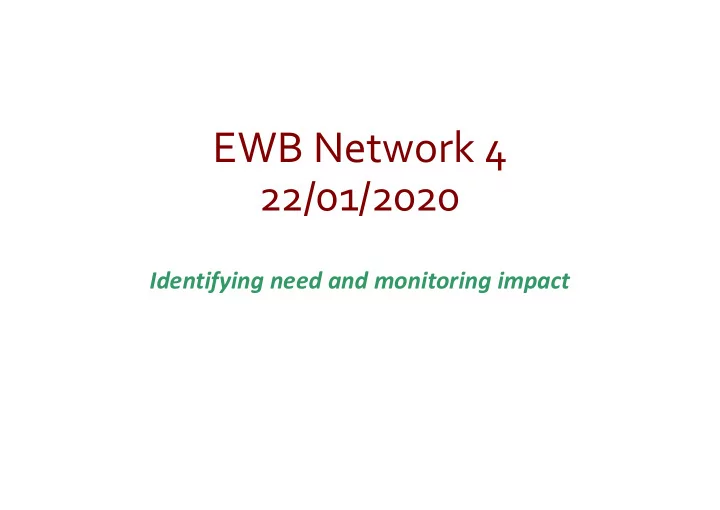

EWB Network 4 22/01/2020 Identifying need and monitoring impact
Welcome and cake Introductions
Agenda 1. Feedback regarding action point 3 2. Few updates 3. Re-introduce the 8 Model Whole School Approach 4. Public Health BREAK AND NETWORK 5. Review the Graduated Approach in response to identifying need 8. Resource sharing
NTH Updates • Preventative workshops • Cygnet • Chill n Chat • FREE book club for mental health leads in school. They send you a free book every month to help build up resources to support SEMH in schools. There is an option for primary focused books or secondary focused. A mix of theory books for staff reference or development and books to use with children https://www.cwmt.org.uk/bookclub
8 Model Whole School Approach https://assets.publishing.service.gov.uk/government/uploads/system/uploads/attachment_data/file/414908/Final_EHWB_draft_20_03_15.pdf Key question: How does the school or college assess the needs of students and the impact of interventions to improve wellbeing?
Links with the Ofsted inspection framework NICE guidance recommends: When inspecting the quality of leadership in and That secondary education providers: management of the school Ofsted inspectors should consider the effectiveness of monitoring and Systematically measure and assess young evaluation and the extent to which it is shared with people’s social and emotional wellbeing governors. They should also consider how well the and use these outcomes as the basis for school meets the needs of all vulnerable groups of planning activities and evaluating their pupils impact Assessing and responding to the emotional health and wellbeing needs of children and learners, and taking steps to mitigate the impact this has on their capacity to learn could provide supportive evidence in relation to all key judgement areas.
Tools… • There are a variety of tools that education settings can use as the basis for understanding and planning a response to pupils’ emotional health and wellbeing needs. • The tools range from simple feedback forms to validated measures which can focus on both wellbeing and mental health. • It is equally important to be able to record and monitor the impact of any support that is put in place. • What tools are you currently using in your provisions for assessment of SEMH needs, and for monitoring impact of intervention?
The Graduated Approach: assessing need … Assessment tools to understand severe SEMH needs that are impacting profoundly on ability to access curriculum. (Would expect these CYP to be referred to services) Assessment tools to understand moderate SEMH needs that are impacting on ability to access curriculum. A whole school approach to promoting positive EWB for all CYP. Mandatory “check- ins”
Break
Assessment tools to consider at Universal level • Training for all staff • Staff confident in noticing emerging SEMH needs, and the impact on learning/thriving • To make it less likely that mild difficulties will become more severe, schools will need to maintain; • Quality first teaching • An inclusive school ethos • A positive learning environment • Robust circular and pastoral arrangement systems that foster positive rships with CYP and parents/carers • Solution focused approach that empowers CYP to build resilience to cope with SEMH needs • Boxall profile; https://boxallprofile.org/ • THRIVE
Case studies Epson Down’s Primary School uses happy/sad sheets to enable lunchtime staff and class teachers to track emotional wellbeing and look for signs of bullying or withdrawal. The At Langley Primary School each school provides a range of support for child has a peg with their name children from assigning them a on it. Every morning and at lunchtime buddy to providing a ‘Circle points throughout the day they of Friends’ intervention, xxix a team are invited to place the peg on of support the class’s feelings chart. This gives the teacher some immediate feedback as to how each child is feeling. Any case studies around the room?
Assessment tools to consider at Targeted level • More specific training offered to key staff • Formulation tools e.g. 5 P’s formulation • Stirling children's wellbeing scale (this is a holistic, positively worded scale, 8 to 15 years) http://www.friendsforlifescotland.org/site/The%20Sti rling%20Children's%20Wellbeing%20Scale.pdf • Warwick-Edinburgh mental wellbeing scale (WEMWBS - positively worded scale that can be used to measure wellbeing with young people aged 13 and over) https://warwick.ac.uk/fac/sci/med/research/platform/ wemwbs/swemwbs_7_item.pdf
Case studies Smithy Bridge Primary School in Rochdale used an adapted version of the Stirling Wellbeing Scale to measuring wellbeing in year 6 students. It used its data to evaluate how well new activities and interventions designed to improve wellbeing were actually working and whether they were worth the investment. Any case studies around the room?
Assessment tools to consider at Specialist level • Referral to specialist services likely to be required • Specific staff training around specialist SEMH needs • Communications with CAMHs or other services • Formulation tools e.g. 5 P’s formulation • Strengths and Difficulties questionnaire (SDQ), designed to focus more on assessing targeted and specialist mental health needs. Youth version for 11-17. Parent/carer/teacher version for 2-17. (emotional, conduct, hyperactivity, peer and prosocial) https://www.sdqinfo.com/py/sdqinfo/c0.py • CORE – 10 Screening measure. 11 – 16. (A score of 10 or below is within normal range. 11-15=mild; 16-20=moderate; 21- 25=moderate/severe; 25 or over is severe) https://www.nhshighland.scot.nhs.uk/Services/Documents/Personality%20disorder%20service/3%20Assess ment/CORE10.pdf • Revised Children’s Anxiety and Depression Scale (RCADS). 8 to 18 years. https://www.corc.uk.net/outcome-experience-measures/revised-childrens-anxiety-and-depression- scale-and-subscales/
Case studies Northorpe Hall CAMHS services Any case studies around the room?
Tools for monitoring impact - Goal Based Outcomes - All the screening tools we have discussed can be used weekly/fortnightly/monthly to measure increase or deterioration in mood - To measure impact directly of intervention; - ORS (13+ years) - CORS (6-12 years) - YCORS (<5 years) - https://www.corc.uk.net/outcome-experience-measures/outcome-rating- scale/ Any case studies around the room?
Steps towards a better future… • Discuss the practice shared today • Next steps… create an independent action point to take back to your provision • Feedback
Recommend
More recommend